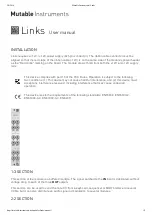
10. Laka is a dense PCB with lots of hardware, and it’s very easy to miss a solder joint in the excitement
to finish the module. Do yourself a favor and double- or even triple-check to make sure every single piece
of hardware and all LEDs are soldered to each pad provided with an ample amount of solder, including
the mechanical pads. This step will make it much more likely your module works first time!
11. If you are confident everything has been soldered in place, we highly recommend performing the
following test before powering on the module for the first time:
a. Set your Multimeter to the Resistance measurement setting (20kΩ if you have to specify range)
b. Place the red (positive) probe on one of the two +12V Input pins at the top of Laka’s 10-pin power
header on the back of the module, and the black (negative) probe on one of the power header’s
six central Ground pins. Observe the resistance on your Multimeter: it should read as a value
above 10kΩ, usually around 14 or 15kΩ.
c. Now, place the red (positive) probe of your Multimeter on one of the six central Ground pins and
place the black (negative) probe on one of the two -12V Input pins at the bottom of the power
header. Observe the resistance reading: it should be similar to the first value (above 10kΩ and
more likely about 14 or 15kΩ).
d. If both values are in the ballpark, this part is over and you can proceed to regular testing and
calibration.
e. If either value reads much lower than 10kΩ, there is most likely a short or at least some stray
capacitance between one of the power rails and ground, which will cause the module to not work
properly and could possibly damage the Schottky power diodes if powered on, as excessive
current will flow across the diode.
f.
Inspect the board for visible shorts, particularly around the 9 TSSOP (fine pitch) IC’s. If any of the
chips even seem to have a little too much solder on the legs (or if you see a short), use copper
braid and your soldering iron to wick as much excess solder as you can from any area that looks
potentially shorted.
g. As you wick away problematic areas, continue measuring the resistance between power pins as
described above until the resistance values are correct.
11. Now it’s time to test your Laka. Plug it in, making sure your power cable’s -12V connection, usually
indicated by the red stripe, is oriented downwards corresponding with the silkscreen. Laka is reverse
diode protected, but we still do not recommend plugging it in backwards for any reason. Then, turn on
case power and observe the behavior of Laka’s LEDs.
With nothing patched to any input, the Offset knobs should influence the behavior of the Channel LEDs,
as should the Bi-Polar Level Faders if the “Zero” switches are in an upward position. Likewise, pressing
the “Advance” button should allow you to manually cycle through the four channels as indicated via the
four single-color LEDs. It’s also worth spending some time patching various signals to the four Channel
inputs and observing the behavior of all 9 Outputs on an oscilloscope, or in a pinch just another module
with LED indication that will respond to CV. Don’t forget to test the Clock and Reset inputs with some 5V
triggers or gates as well in order to confirm that the Sequencer is functional.























